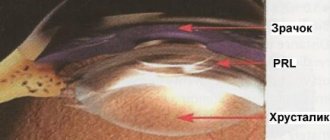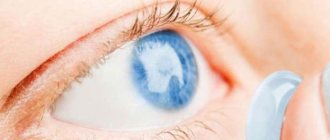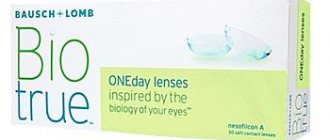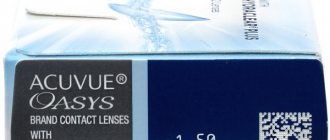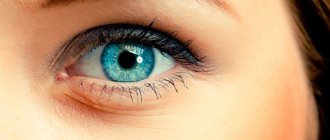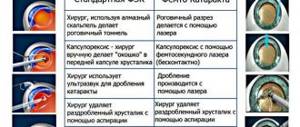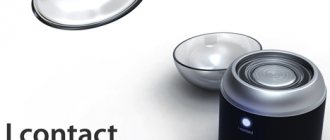The structure of the artificial lens
The intraocular lens, like the natural lens of the eye, is elastic and resilient.
By refracting light rays, it forms an image on the retina, which is processed by the brain and gives us a visual picture of the world around us. An artificial lens includes two structures - an optical element and a support system. The optics of the intraocular lens perform the visual functions of the natural lens, primarily focusing. The supporting contour reliably fixes and holds the new element in the eye chamber. The implant is made of inert biocompatible materials, due to which it is perceived by the body as natural and is not rejected. The optics of the artificial lens include the so-called. diffraction zone, which, in fact, forms a clear image. The support structure fixes the lens in its natural position.
BY TYPE OF CLENS: HARD AND SOFT
Today, soft IOLs are mainly used. The surgical technique is based on minimally invasive principles, so the surgeon needs a lens that can be easily rolled into a tube and inserted into a micro-incision (about 2.5 mm), which will then heal itself. Rigid lenses have been used in the past for strip surgeries. It is not difficult to guess that in order to implant a rigid lens, it was necessary to cut the eyeball almost in half. The rehabilitation period was long and unpleasant. But today hard lenses are a thing of the past. Now they are used only in exceptional cases when laser and ultrasound operations are contraindicated for the patient.
Types of intraocular lenses
In ophthalmological practice, two types of implants are used in the treatment of cataracts: “hard” and “soft” intraocular lenses. Both types are installed in place of the removed clouded lens. The fundamental difference is that a “rigid” lens cannot be installed through a micro-incision in the eye chamber; the surgeon is forced to resort to a full open approach. At the last stage of the operation using this type of lens, sutures are placed on the camera of the eye. This method lengthens the rehabilitation period and carries the risk of complications.
Modern ophthalmological centers in most cases treat cataracts using “soft” lenses. Such an artificial lens is installed through a micro-incision in a folded form, unfolds independently inside the eye and is fixed. After such an operation, the patient does not need long-term rehabilitation; vision is restored within a few days, and the surgical incision is self-sealing.
Modern ophthalmology offers 4 main types of intraocular lenses:
- aspherical lenses;
- toric lenses;
- multifocal lenses;
- Accommodating lenses.
About company
The American company Alcon is one of the world leaders in the production of intraocular lenses. Its doctors have developed a revolutionary material that meets the requirements of modern ophthalmology.
Alcon intraocular lenses appeared on the market in 1994. Since then, eye doctors around the world have been using the products to restore vision in patients with varying degrees of myopia, farsightedness, astigmatism or cataracts. Patients note improved vision, do not feel pain and burning and other side effects of operations.
Aspheric intraocular lenses
Surgical treatment of cataracts with replacement of the lens with an intraocular lens is highly effective. However, in a number of cases, due to a mismatch between the optical systems of the eye and the artificial implant, against the background of a significant increase in visual acuity, the effect of a light halo around objects occurs. These spherical aberrations distort the image and cause discomfort.
Passing through the optical systems of the new lens and the eye as a whole, light rays are refracted at different angles; the consequence of this is a wave-like halo in the field of view, glare, reflections, highlights (especially in twilight conditions, when the pupil is dilated). Special aspheric intraocular lenses are designed to correct these unwanted effects. Such an implant has the same optical properties over its entire surface. All zones of the aspheric lens equally bring the light beam into focus, resulting in a clear image being formed on the retina.
Useful video
More useful and relevant information can be found here:
AcrySof lenses are an excellent solution for the treatment of refractive errors and cataracts. This is a healthy alternative to wearing glasses and contact lenses. Timely consultation with a doctor for eye diseases guarantees the preservation of excellent vision, a high quality of life and prevents the development of premature vision loss.
Author's rating
Author of the article
Alexandrova O.M.
Articles written
2029
about the author
Was the article helpful?
Rate the material on a five-point scale!
( 3 ratings, average: 4.67 out of 5)
If you have any questions or want to share your opinion or experience, write a comment below.
Toric intraocular lenses
Until recently, surgical treatment of cataracts was associated with serious difficulties in situations where lens opacification is combined with astigmatism. This is a common occurrence in ophthalmology. Corneal astigmatism, combined with impaired elasticity of the lens, produces double distortion when refracting light rays.
Surgical treatment of cataracts in such patients, although it provided a significant improvement, required further wearing of special cylindrical glasses to correct distortions in certain areas of the optical field.
For patients in this group, special toric implants were developed. Installing such a lens solves both problems at once. Vision correction occurs in a comprehensive manner - both cataracts and corneal astigmatism are eliminated. As a result, not only optical performance near and in the dark improves, but also distance vision.
AcrySof® Restor® Toric
This multifocal lens is most suitable for correcting complex refractive errors. AcrySof® Restor® Toric is made from hydrophobic acrylic.
Applicable for:
- restoration of normal vision after cataract removal;
- correction of high myopia;
- correction of complex astigmatism.
Hydrophobic acrylic has a yellow chromophore, which allows you to protect your eyes not only from ultraviolet radiation, but also from blue rays of visible light radiation. The AcrySof® Restor® Toric model is the best for the correction of cataracts combined with astigmatism.
The AcrySof ReSTOR lens has all the positive characteristics of AcrySof Natural. Thanks to diffractive-refractive optical technology, a person can see clearly at different distances already in the first days of the postoperative period. Moreover, he fully feels all the richness of the colors of the surrounding world.
It has a diopter range from +6.0 to +30.0 diopters.
There are such lens models:
- SND1T2 AcrySof Restor Toric
- SND1T3 AcrySof Restor Toric
- SND1T4 AcrySof Restor Toric
- SND1T5 AcrySof Restor Toric
- SND1T6 AcrySof Restor Toric
Multifocal intraocular lenses
A decrease in visual acuity after 40 years is considered normal due to the natural weakening of accommodation. Since with age the reactions and mobility of all structures of the body weaken to one degree or another, the ability of the eye to change vision from distant objects to near objects also changes. The lens becomes denser and loses its original elasticity. Working with small objects or making precise movements becomes difficult without glasses. At the age of 60-70 years, weakening of accommodation requires constant wearing of glasses in everyday life.
Multifocal lenses (pseudo-accommodating) are designed for comprehensive vision correction. The design of such an implant provides not one, but several focuses. This allows for sufficient visual acuity at long and near distances. Most patients (80%) with multifocal lenses can avoid glasses entirely. Based on the diagnostic results, one of two types of such implants is selected: a lens of a mixed diffractive-refractive nature or a lens with combined radial sectors.
AcrySof® Multi-component models
These are lenses made from two or more different optical materials with different properties. They are suitable for correcting visual impairment caused by various unfavorable factors.
Lenses are installed when:
- complex and mixed type of astigmatism;
- myopia accompanied by complicated astigmatism;
- progressive high myopia complicated by cataracts;
- complicated farsightedness;
- other types of visual impairment that are not amenable to traditional glasses and contact lenses.
Multi-component lenses are equipped with blue light filters and reliably protect your eyes from ultraviolet radiation.
Presented by models:
- MN60AC AcrySof
- MN60MA AcrySof
- MA60AC AcrySof
- MA60MA AcrySof.
Accommodating intraocular lenses
Accommodating intraocular lenses are as similar in structure and properties as the natural lens of the eye. The structure of this implant is such that in its work it interacts with the eye muscles. The lens changes shape, bending and moving like a natural lens.
Accommodating intraocular lenses simultaneously solve the problem of cataracts and farsightedness, which is common in older patients. After installing this type of artificial lens, vision in its characteristics approaches those characteristic of young people. This type of lens allows you to restore good vision both near and at long and medium distances. The lens is mobile and, under the action of the eye muscles, is easily rebuilt, imitating the natural ability to focus.
BY METHOD OF VISION CORRECTION: MONOFOCAL AND MULTIFOCAL
After surgery, a monofocal lens corrects distance vision and eliminates vision defects caused by cataracts, but cannot completely imitate the natural lens and focus at different distances. Therefore, the patient will need glasses for close distance.
A multifocal IOL is a premium lens that, on the contrary, imitates the work of the natural lens and corrects vision both far and near. The optics of such a lens are complex and consist of several “zones”, each of which is responsible for its own area.
Cost of artificial lenses (IOLs)
| Name of intraocular lens | Country of Origin | IOL price (RUB, 1 piece) | |
| MZ60BD Silco | USA | 5 000 | |
| Hydro-Sense Aspheric Rumex Ltd | Great Britain | 9 000 | |
| Acrysof Multi-Piece Alcon | USA | 19 500 | |
| Acrysof Natural Alcon | USA | 19 500 | |
| Acrysof IQ Alcon | USA | 22 000 | |
| ZEISS CT ASPHINA 509 M | Germany | 23 500 | |
| Acrysof ReSTOR Alcon | USA | 48 000 | |
| Acrysof SND1T5 Restor Toric Alcon | USA | 70 000 | |
| ZEISS AT LISA 809 M | Germany | 51 000 | |
RAYNER SUPERFLEX ASPHERIC
Soft aspherical model. Provides excellent distance vision. The model is securely fixed and easily implanted. The lens design is created without sharp corners, which avoids aberrations. One of the “highlights” of the model is the rectangular edge of the optics. This design minimizes the risk of secondary membranous cataracts. Manufacturers also promise excellent centering and rotational stability of the lens. Unlike other models, this IOL has zero spherical aberration, thus smoothing out aberrations of the cornea itself. The optics of this lens provide excellent focusing, minimize image distortion, improve contrast and sharpness, and depth of vision. At the same time, the picture quality does not depend on the lighting. This model will provide the patient with excellent distance vision, but glasses will be required for reading.
Spherical and aspherical IOLs
The aspherical shape of the IOL means that no matter where the light hits the lens, it will be refracted everywhere with the same force, both in the center and at the edges of the lens. This is important in the dark, when the pupil dilates to its maximum.
The advantage of these lenses is minimal glare from light sources in the evening and at night. For example, from the headlights of oncoming cars, which is very important for the safety and comfort of all motorists. Aspheric lenses also have better color rendering and contrast.
The spherical shape of the IOL means that the artificial lens refracts light with different strengths in different parts, for example, in the center of the lens and at the edges. This creates a certain light scattering, which negatively affects the quality of vision. There may be glare and highlights.
Multifocal toric IOLs
The line of IOL models is completed with toric multifocal artificial lenses. If the patient had astigmatism before the operation, and he wants to see both far and near without glasses as in his youth, then only such an artificial lens is indicated for him.
As you may have guessed, this is the most expensive type of IOL that exists. You pay for comfort, quality of vision, and the complexity of lens calculations.
